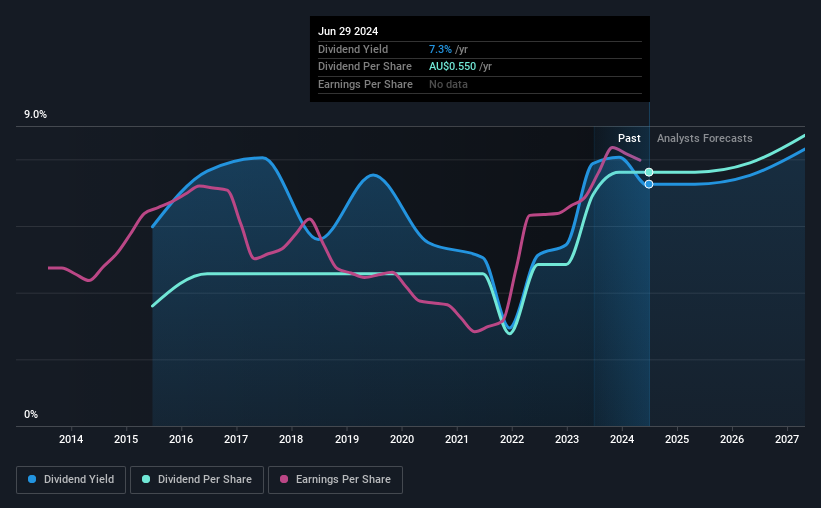Ricegrowers' (ASX:SGLLV) Upcoming Dividend Will Be Larger Than Last Year's
Ricegrowers Limited (ASX:SGLLV) will increase its dividend on the 25th of July to A$0.45, which is 13% higher than last year's payment from the same period of A$0.40. This makes the dividend yield 7.3%, which is above the industry average.
Check out our latest analysis for Ricegrowers
Ricegrowers' Payment Has Solid Earnings Coverage
A big dividend yield for a few years doesn't mean much if it can't be sustained. Based on the last payment, Ricegrowers was quite comfortably earning enough to cover the dividend. This indicates that a lot of the earnings are being reinvested into the business, with the aim of fueling growth.
The next year is set to see EPS grow by 18.0%. Assuming the dividend continues along recent trends, we think the payout ratio could be 56% by next year, which is in a pretty sustainable range.
Ricegrowers' Dividend Has Lacked Consistency
Ricegrowers has been paying dividends for a while, but the track record isn't stellar. This makes us cautious about the consistency of the dividend over a full economic cycle. The dividend has gone from an annual total of A$0.26 in 2015 to the most recent total annual payment of A$0.55. This implies that the company grew its distributions at a yearly rate of about 8.7% over that duration. It's good to see the dividend growing at a decent rate, but the dividend has been cut at least once in the past. Ricegrowers might have put its house in order since then, but we remain cautious.
The Dividend Looks Likely To Grow
With a relatively unstable dividend, it's even more important to see if earnings per share is growing. We are encouraged to see that Ricegrowers has grown earnings per share at 12% per year over the past five years. Since earnings per share is growing at an acceptable rate, and the payout policy is balanced, we think the company is positioning itself well to grow earnings and dividends in the future.
We Really Like Ricegrowers' Dividend
In summary, it is always positive to see the dividend being increased, and we are particularly pleased with its overall sustainability. The company is easily earning enough to cover its dividend payments and it is great to see that these earnings are being translated into cash flow. Taking this all into consideration, this looks like it could be a good dividend opportunity.
Investors generally tend to favour companies with a consistent, stable dividend policy as opposed to those operating an irregular one. Still, investors need to consider a host of other factors, apart from dividend payments, when analysing a company. Taking the debate a bit further, we've identified 2 warning signs for Ricegrowers that investors need to be conscious of moving forward. Looking for more high-yielding dividend ideas? Try our collection of strong dividend payers.
Have feedback on this article? Concerned about the content? Get in touch with us directly. Alternatively, email editorial-team (at) simplywallst.com.
This article by Simply Wall St is general in nature. We provide commentary based on historical data and analyst forecasts only using an unbiased methodology and our articles are not intended to be financial advice. It does not constitute a recommendation to buy or sell any stock, and does not take account of your objectives, or your financial situation. We aim to bring you long-term focused analysis driven by fundamental data. Note that our analysis may not factor in the latest price-sensitive company announcements or qualitative material. Simply Wall St has no position in any stocks mentioned.
Have feedback on this article? Concerned about the content? Get in touch with us directly. Alternatively, email editorial-team@simplywallst.com

 Yahoo Finance
Yahoo Finance 
